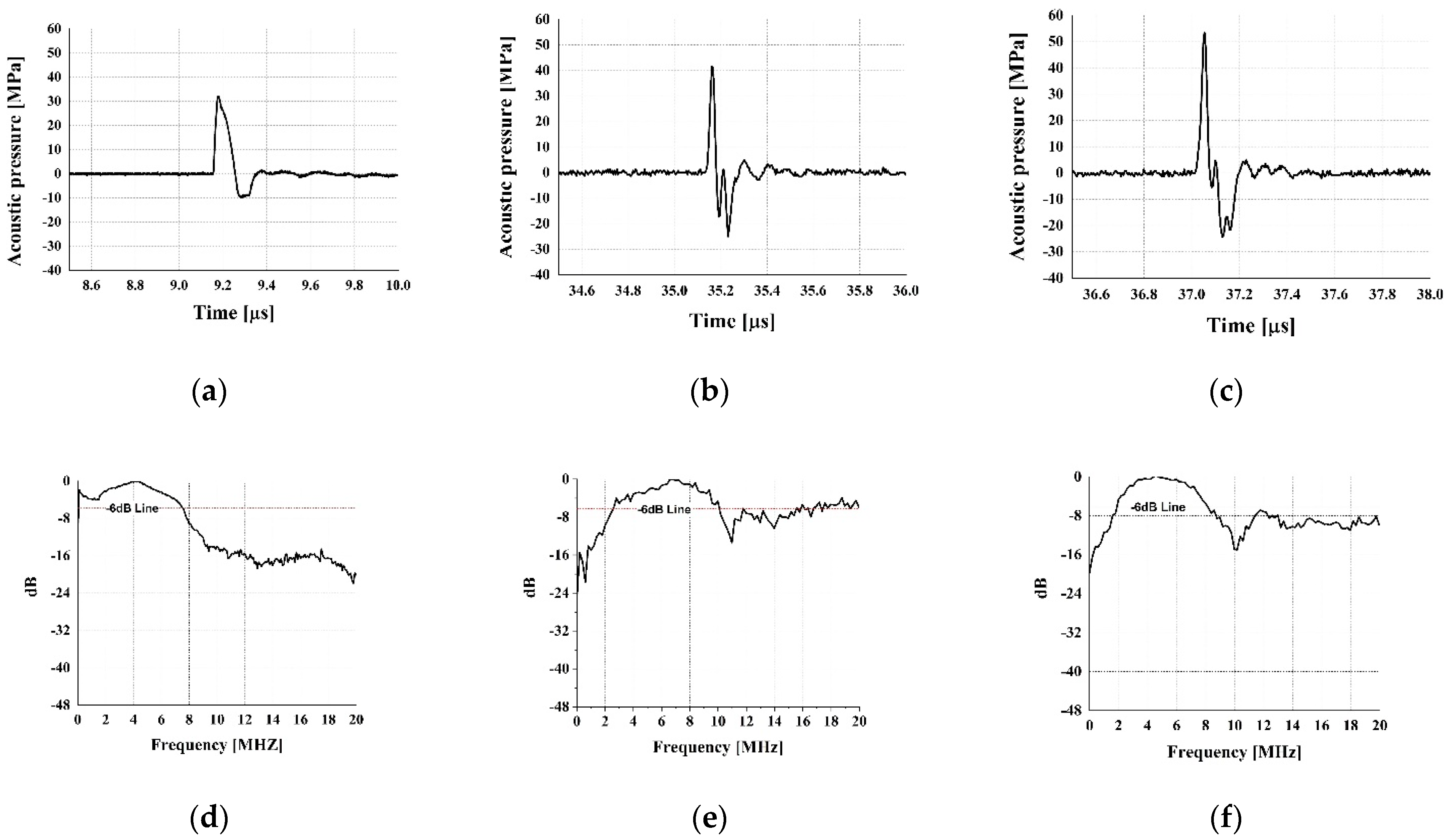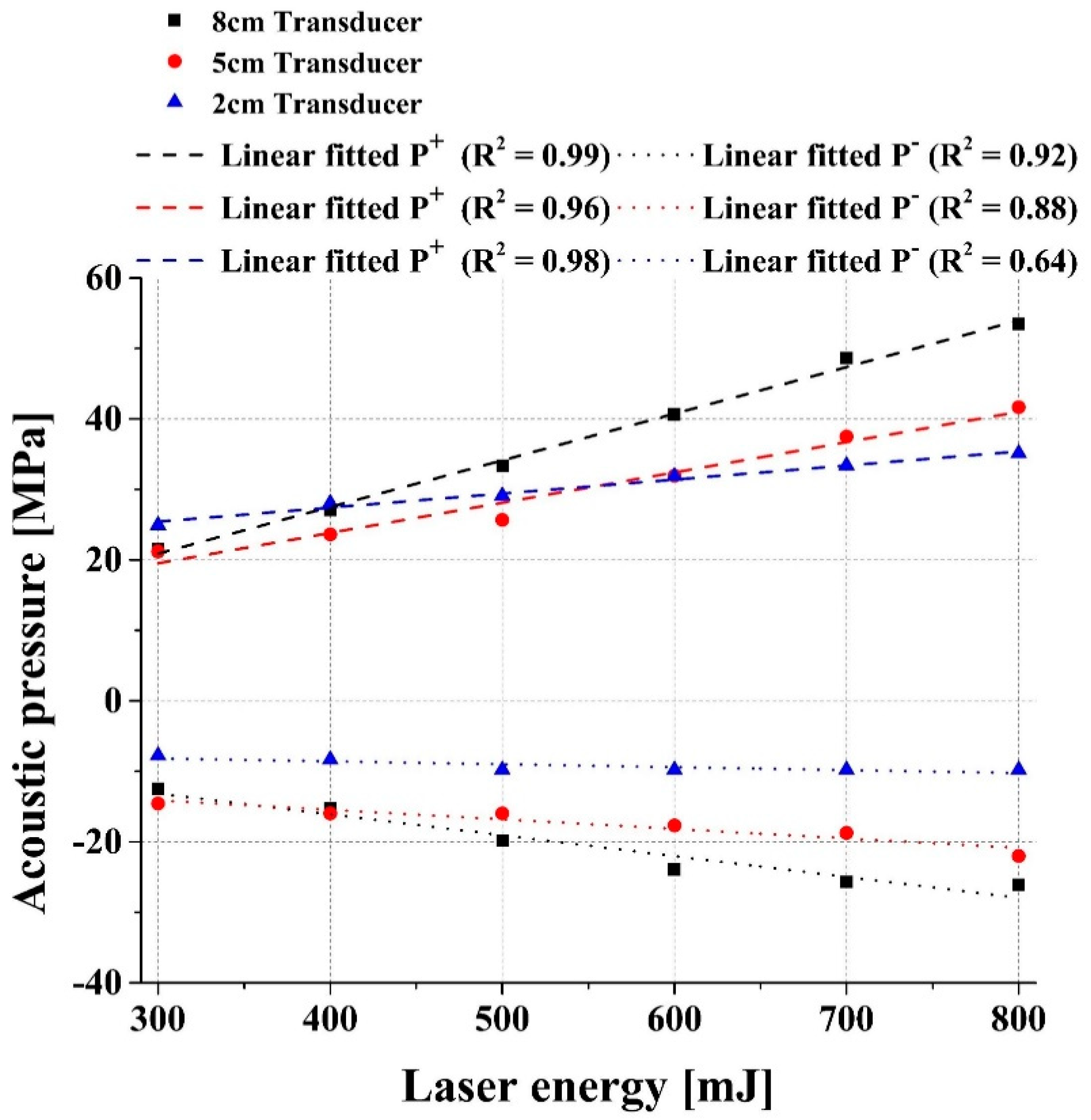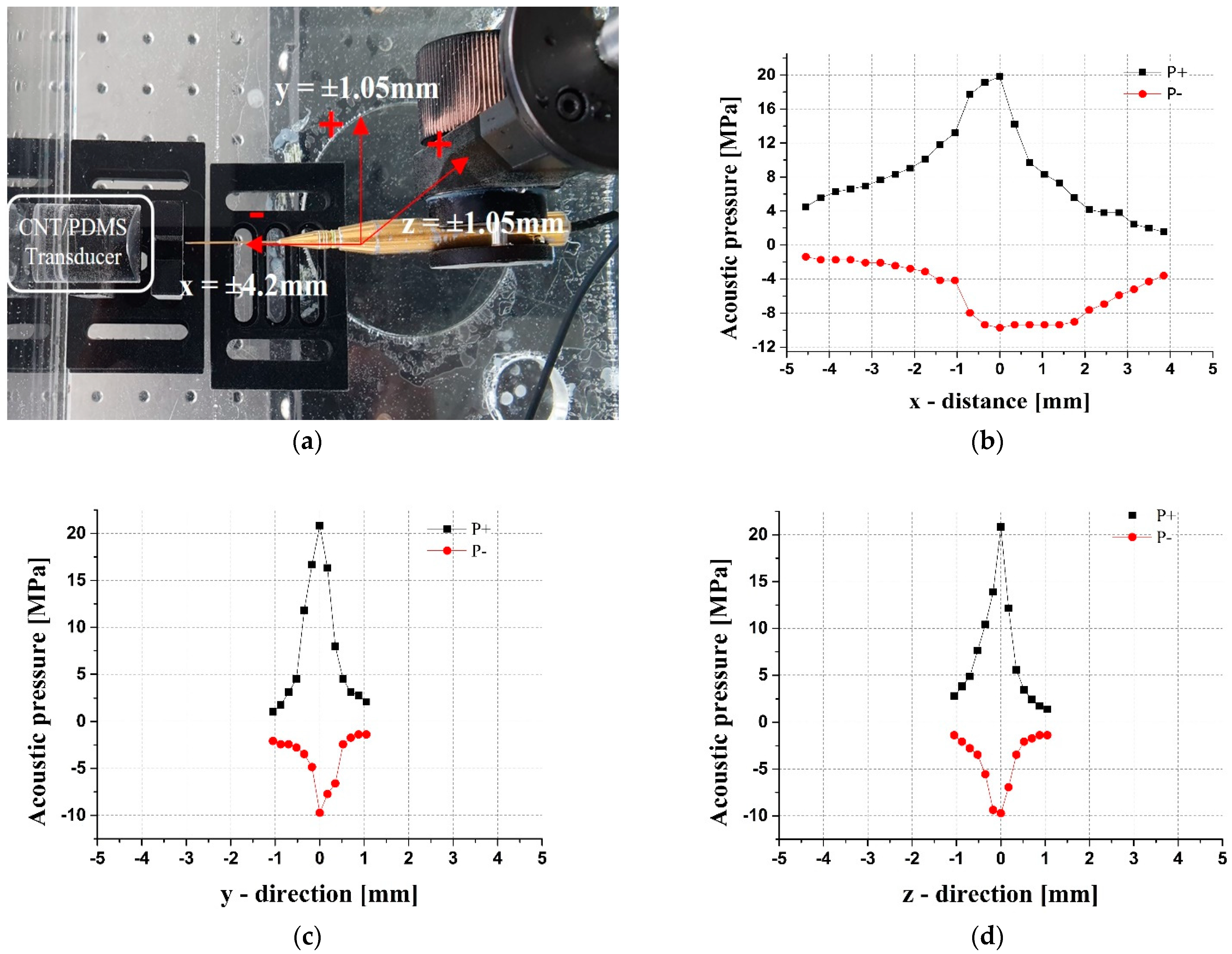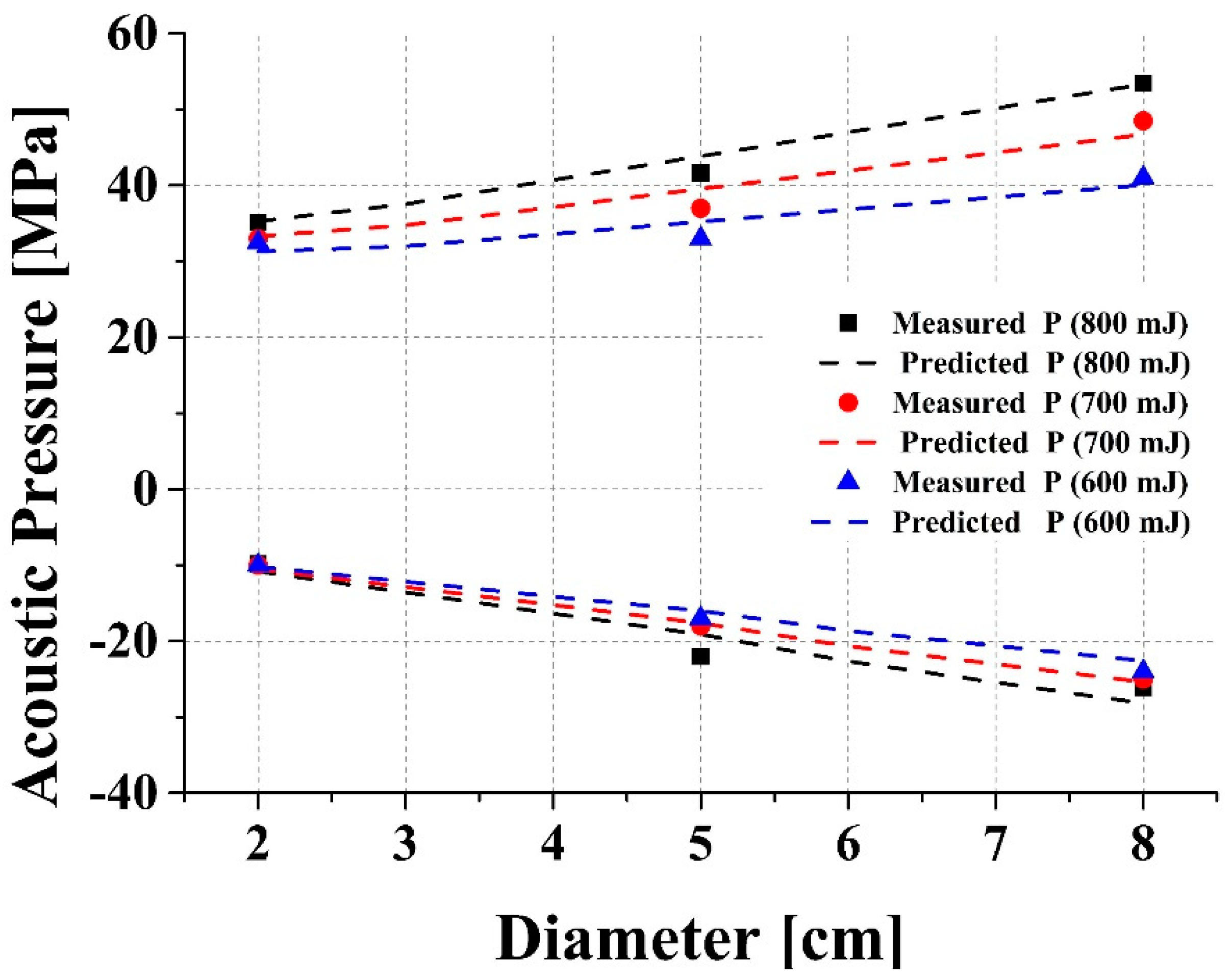1. Introduction
Laser-guided focused ultrasound (LGFUS) is a promising alternative to other ultrasound generating modalities (electric, electromagnetic, and piezoelectric) to produce broadband ultrasound signals [
1]. LGFUS has proven successful in providing a better alternative to non-invasive procedures for therapeutic purposes and many other biomedical applications [
2]. The most prominent mechanism of LGFUS is the thermoelastic effect, also known as the photoacoustic or optoacoustic effect [
3], in which laser energy is converted into acoustic energy using the thermal and elastic effect of the materials used in the ultrasound transducer fabrication. Another major characteristic feature of LGFUS is the generation of the shock wave at the focal point with a significant positive phase and long trailing negative phase, as formed in shock wave lithotripsy [
4]. These shock waves can be achieved using specially constructed photoacoustic composite transducers for the efficient conversion of laser energy into acoustic energy [
2].
Such composite transducers constitute a high optical absorbing material and an elastomeric polymer grown on a substrate [
1]. High optical absorbance material is required to absorb maximum light from the source with a minimum reflection, and an elastomeric polymer with a high heat expansion coefficient is needed to convert it into acoustic energy with a high amplitude [
1,
5]. CNTs have a high light absorption ratio and generate high temperatures locally under laser exposure [
6]. Additionally, CNTs enhanced peak pressure to more than one order of magnitude compared to metals by reducing reflectance and increasing the maximum optical absorbance [
7,
8]. Under pulsed laser excitation, CNT composites generate extreme acoustic pressure: eighteen times stronger than a Cr (Chromium) film and five times more potent than a gold nanoparticle composite with the same elastomeric polymer [
9]. Furthermore, rapid heat diffusion to the surrounding medium is one of the main characteristics of CNTs [
4]. Due to the nanometer spatial configuration of CNTs, thermal energy can be transferred to the adjacent expanding layer. Polydimethylsiloxane (PDMS) has been widely used as a thermally expanding layer because of its high thermal coefficient of volume expansion (α = 0.92 × 10
−3 K
−1) [
6]. Therefore, when CNTs are heated, they immediately transfer most of their absorbed heat energy to the adjacent PDMS layer, which can cause rapid thermal expansion with a high amplitude [
4]. LGFUS can produce high frequency (>15 MHz) and acoustic pressure of >50 MPa from a single element lens (6 mm in diameter) via a CNT and PDMS composite transducer on a concave surface [
4]. Baac et al. confirmed that CNT-PDMS films can endure a higher optical fluence than a chromium (Cr) film, making them a perfect composite film to apply the maximum available laser energy to optoacoustic excitation. The structural characteristics of the lamination layers define them as excellent materials for high amplitude and high-frequency ultrasound generation [
10].
LGFUS has used different techniques to generate shock waves and investigate the effect of different physical parameters on shock wave characteristics. Baac et al. used a small optoacoustic lens of varying diameters to determine the peak positive and negative pressure of the focal waveform (6 mm and 12 mm) and attained a maximum positive pressure of more than 50 MPa [
4]. Richard et al. utilized functionalized CNTs and dissolved them into a PDMS solvent before coating them on a substrate. They employed planar optical fibers as the substrate and achieved maximum pressures of 3.6 MPa and 4.5 MPa [
11]. Furthermore, experiments using CNTs of different diameters and tube lengths were also carried out to investigate the effect of the thermal conductivity of CNTs on the performance of optoacoustic transducers, resulting in CNTs with a diameter and length of 8 nm and 10–30
m, respectively [
12]. Yixuan et al. used different thicknesses of CNT-PDMS composites on pure PDMS to discover better-performing transducers and found a decrease in the thermal conductivity of composite transducers due to a reduction in the thickness of the CNT film [
13]. In another study, the characteristics of LGFUS were evaluated using a perforated photoacoustic lens, and a peak positive pressure of 46.5 MPa was attained [
14]. These studies provide significant knowledge and an understanding of the CNT-PDMS composite structure and its relative impacts on shock wave characteristics. However, no study has been conducted on the characterization of shock waves using composite transducers with diameters that are more practical to use (up to 8 cm or more) in order to understand their relative effect on the properties of shock waves.
CNT-PDMS composite transducers are a promising modality in the field of optoacoustic transducers due to their exceptional heat conduction and expansion properties. They can generate high optoacoustic pressure at the focal point. Shock waves, one of the characteristic features of acoustics, are used for many therapeutic purposes, including histotripsy and shock wave lithotripsy for kidney and liver stones [
15,
16]. Therefore, optoacoustic transducers are another effective way of generating shock waves with similar or improved properties for use in different applications with improved performance.
This paper investigates the effect of changing diameter in a CNT-PDMS composite transducer on the peak amplitude and properties of shock waves. The areas of interest are the maximum positive and negative pressure generation of shock waves at the focal point using larger diameters, compared to previous studies. The purpose of using larger diameters is to fabricate transducers with more suitable sizes and peak pressures at the focal point. Smaller diameters are beneficial for cell culture studies, but to further investigate the effect of shock waves, as well as acoustic attenuation and impedance, in transcranial studies, miniature composite transducers cannot be effectively used. Therefore, this paper aims to construct a CNT-PDMS composite transducer with maximum pressure generation using more practical diameters.
2. Materials and Methods
2.1. Fabrication of a CNT-PDMS Composite Transducer
To fabricate all composite transducers, concave-shaped polymethyl methacrylate (PMMA) was used as a substrate. Multiwalled CNTs (MWCNTs) (purity: 85%wt, 90%wt. refining, diameter: 5~20 nm, length: ~10 m) (Applied Carbon Nano, Pohang-si, Korea) were used for the thermal conductivity layers. PDMS (SYLGARD 184, Dow Silicones Corporations, Auburn, MI, USA) was used for an elastomeric heat expansion layer. MWCNTs were grown on a PMMA surface using a spray coating. The PDMS layer was then spin-coated on CNTs at 2000 rpm for 2 min. The PDMS was cured at 100 °C for 1 h. In the fabrication process, structural changes through producing different diameters were introduced: composite transducers with diameters of 2 cm, 5 cm, and 8 cm and with focal lengths of 1.4 cm, 5 cm, and 5 cm, respectively, were fabricated.
2.2. Experimental Setup
The experimental setup for optoacoustic wave signal generation and characterization is illustrated in
Figure 1. A Q-switched Nd: YAG laser (STL-5000Q, Stratek, Anyang-si, Korea) was employed as an optical source with a wavelength of 532 nm and a pulse repetition frequency of 2 Hz. The diameter of the laser beam was initially 6 mm. It expanded up to 80 mm, increasing the distance from the composite transducer after passing through the beam expander. The composite transducer of interest was mounted inside a degassed water tank and aligned with the laser system. The laser beam has a spatial beam profile of Gaussian distribution with a much higher acoustic pressure at the center than the off-axis location [
8]. A 0.2 mm needle hydrophone (NH0200, Precision Acoustics Ltd., Dorchester, UK) was aligned with an acoustic wave generation setup and immersed inside the degassed water tank for the acoustic signal measurement. The needle hydrophone was fixed on an XYZ base with adjustable handwheels to find the focal point and range of the acoustic pressure. The distance of the needle hydrophone from the composite transducer was kept to the focal length of the respective composite transducer. The acoustic wave signal recorded through the needle hydrophone was amplified using a preamplifier (HP Precision Acoustics. Ltd., Dorchester, UK) and fed to an oscilloscope (LT354, Lecroy, New York, NY, USA), which was connected to a personal computer to record the signal data. An external trigger from the laser system was employed to synchronize the time series of laser excitation with the data collected from the oscilloscope. Ultrasound wave signals received by the needle hydrophone were postprocessed to calculate the acoustic pressure and investigate for further characterization.
2.3. Measurement of Acoustic Intensity around Focal Point
The needle hydrophone was moved along x, y, and z planes to investigate the acoustic attenuation away from the focal point. Along x-axis (which is a wave propagation axis), the needle was moved in the range of 4.2 mm from the focal point. Along the y-axis and z-axis, the needle hydrophone was moved in the range of 1.05 mm concerning the focal point.
4. Discussion
In this study, composite transducers with larger diameters (2 cm, 5 cm, and 8 cm) were used for the experiments, and higher peak amplitudes of the shock waves were successfully achieved. The three optoacoustic transducers exhibited a similar pattern of increased peak pressures with an increase in diameter. As the diameter of the transducer increases, the expansion of the laser energy also increases, resulting in higher peak pressures. Under the same laser energy (800 mJ/pulse), the transducer with an 8 cm diameter produced the maximum positive and negative amplitudes of 53 MPa and −25 MPa, respectively. The laser-generated acoustic pressure increased with the increased input of laser energy. The higher amplitudes of shock waves obtained in this study have the potential for utilization in many applications, such as transcranial studies.
The pattern of the shock waves was similar in all three transducers. Optoacoustic-generated shock waves have a very short duration of 0.1~0.4
[
2] compared to shock waves from other sources (electrohydraulic, electromagnetic, and piezoelectric) [
15,
16]. The shock wave observed in this study showed a duration of 0.2
. (
Figure 2). The characteristic feature of the shock wave with a broad frequency distribution was observed in the frequency domain of the signals. In
Figure 2, the frequency spectra show a similar pattern with a center frequency and −6 dB bandwidth less than 10 MHz, although the composite transducer with a 2 cm diameter shows large amounts of energy at a frequency range of less than 2 MHz. In another study involving smaller transducers with diameters in millimeters, similar peak amplitudes and spectra were achieved but at a higher center frequency of around 20 MHz [
4].
As shock waves constitute higher frequency components, they attenuate faster at high frequencies [
8]. This explains the faster decay of the shock wave. When the relationship between laser energy and different diameters of the composite transducer was analyzed, it was observed that the measured peak pressures have a linear relationship with the laser energy, which is also confirmed in previous studies [
18]. However, in negative peak pressures, the 2 cm transducer was saturated at higher laser energy levels (
Figure 3) [
10]. We observed another important phenomenon: at a lower laser energy, the 5 cm and 8 cm transducers show almost similar positive and negative pressures, but when the laser energy is increased, there is a difference between the peak pressures. The CNT-PDMS films could withstand higher optical fluence, and this endurance of CNT-PDMS makes it possible to increase the laser energy to the maximum available optical energy [
10]. Otherwise, materials with less laser fluence can be damaged when the laser beam’s energy is increased [
2].
Figure 5 shows an agreement between the measured and predicted peak amplitudes of the shock waves with the different diameters of the CNT-PDMS composite transducers. The reference laser energy values used for predicting peak amplitudes are higher values over 600 mJ/pulse. In an experimental setting, higher energy values are usually employed as it is useful to make predictions at these levels. For lower energy values, there is little difference; therefore, it is not very practical to make predictions at these levels.
The comparison between the shock wave signal of the CNT-PDMS composite transducer and extracorporeal shock wave therapy (ESWT) shows that the former has a narrower beam width than the latter. The shock wave generated by the CNT-PDMS composite transducer has a beam width of 2.5 mm in the axial direction and 0.70 mm in the lateral direction (
Figure 4). On the other hand, the beam width of ESWT measured in [
19] is 14 mm in the axial direction and 2 mm in the lateral direction. It shows that shock waves generated through optoacoustic effects achieve a tighter focus than those generated through other sources. Moreover, in ESWT, the long negative trailing phase of the shock wave appears before the geometric focal point towards the face of the transducer, while in the CNT-PDMS composite transducer, the trailing negative phase of the shock wave is at the focal point increasing the focal depth (
Figure 4).
In the previous studies, smaller diameters were used but only for cell culture studies [
4]. In order to construct a transducer that can be used for practical applications such as transcranial studies, larger diameters are required [
9,
20]. By using larger diameters, high pressures of shock waves were achieved in this study. Therefore, to improve laboratory work in practice, more suitable diameters with efficient performance are required. The experimental results of this study can be compared with simulation results in the future for further validation.













